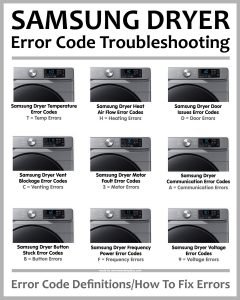
Understanding the “HE” Error Code
When your Samsung dryer displays the “HE” error code, it’s essentially waving a little flag that says there’s a heating problem. This could mean a variety of things. Imagine you’re trying to boil water on the stove, but the burner isn’t getting hot enough. Similarly, your dryer might be struggling to heat up to the required temperature to dry clothes efficiently. It’s trying, but something’s interfering with its ability to generate or maintain the heat needed.
There are several potential culprits behind this message. The most common reason might be a malfunction with the dryer’s heating element, which is like the heart of the machine’s warming capabilities. If the heating element fails, it’s like trying to heat your home in the winter with a broken furnace—your clothes won’t dry, no matter how long you leave them in there. Another possibility is that the thermostat or thermal fuse has tripped or failed, disrupting the dryer’s internal temperature regulation.
Moreover, the issue might be as simple as a clogged vent or lint filter, blocking the airflow that’s essential for drying clothes. Imagine trying to breathe through a straw that’s been pinched—you’d probably struggle to get any air through. Similarly, a blocked vent can cause the dryer to overheat or not heat sufficiently, triggering the HE error code.
Is It Safe to Use the Dryer with the HE Code?
Now, you might be wondering, “Is it okay to keep using the dryer while I figure this out?” In short, it’s usually best to avoid using the dryer until the issue is resolved. Here’s why: operating a dryer that isn’t functioning properly can lead to further damage or, in rare cases, even present a fire hazard. Just as you wouldn’t keep driving a car with a flat tire, it’s wise to pause and fix the issue before proceeding with your laundry routine.
Continuing to use a dryer with heating issues could strain the machine further, leading to more extensive repairs down the line. Moreover, trying to dry clothes without proper heat could end up wasting energy and time, with clothes coming out damp rather than dry. It’s much like attempting to bake bread in a cold oven—without the necessary warmth, the outcome simply won’t be as expected.
Instead, consider taking a break from using the machine to investigate the problem. This doesn’t mean you have to go without clean clothes; you may need to rely on air drying or visit a laundromat temporarily while resolving the issue. This approach ensures the safety of your appliance and home until the dryer can operate without error messages.
Steps to Troubleshoot and Resolve the HE Error Code
So, what can you do to address the HE error code? First, let’s start with the basics. Check the lint filter and make sure it’s clean. You’d be surprised how often a simple cleaning can solve the problem, since a clogged lint filter can impede airflow akin to a blocked chimney, preventing proper functioning. Next, inspect the dryer’s venting system to ensure it’s not obstructed. Clearing any buildup here can often rectify the issue and restore your dryer’s efficiency.
For those who are a bit handier, you might want to check the heating elements and thermostat with a multimeter to ensure they’re working correctly. If these components seem faulty, replacing them can often fix the problem. However, if you’re not comfortable poking around inside appliances, it’s totally okay to call a professional. Appliance repair technicians can diagnose and fix these issues with expertise, saving you the hassle and worry.
Finally, as a preventative measure, consider scheduling regular maintenance for your dryer. Just as you’d take your car in for regular services, ensuring your dryer is in tip-top shape can prevent future headaches. Regular cleaning and checks can keep your dryer running smoothly, meaning fewer error codes and more peace of mind.
Through understanding and addressing the HE error code on your Samsung dryer, you’ll not only extend the lifespan of your appliance but also ensure your laundry days continue without a hitch. Remember, taking the time to investigate and resolve these issues is a small investment for the safety and efficiency of your home.